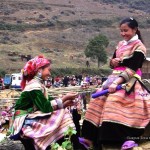Sapa Homestay
Sapa is famous for both its fine, rugged scenery and also its rich cultural diversity. If trekking is your thing, why not opt for a two or three day experience incorporating homestays in the villages of your choice. What better way to expose yourself to the cultures and colour of Vietnam’s ethnic minorities on a trek through terraced rice paddies, bamboo groves and traditional villages all in the shadow of Mount Fansipan.
Sapa Travel work in association with a number of host families throughout the Hoang Lien Son Mountain range and each village has something different to offer. Our homestay partnerships grew out of Sapa Travel’s mission to promote and support responsible travel. From the popular Lao Chai and Ta Van homestays to the quiet and remote village of Lao Chai San, each homestay has a different feel, but all offer the traveller a rare glimpse into the way of life that has all but vanished from the rest of Asia. Here you will find no welcome mats or rehearsed “cultural” parades, just real people living real lives who greet visitors with genuine warmth and real smiles.
There are two types of homestay. The choice is either a well established mini guest house style homestay with other travellers or staying in an a traditional Hmong home as exclusive guests. In both, expect to experience village life in all its glory. On the plus side, you will get some quality time with the wonderful Black Hmong community. Hmong homes are set within the famed rice paddies and have incredible views if the weather permits. On the downside, expect to be awoken early by roosters or the families livestock. You can choose towards the end of your trek which type of homestay you want to stay.
Your choice of trek often influences the homestay we can use. The guesthouse style homestays are quite large and built from wood or brick. There are no separate bedrooms or en suit bathrooms and only some homestays have wifi. The guesthouses do have electricity. Typically, there is one big open space upstairs, which is then divided into zones with mosquito nets. The photos below show the sort of setup you might expect. These homestays normally have a couple of western style toilets and warm showers. The number of guests varies per day, but typically, two to three groups will share a particular homestay on any given night.
There are facilities to buy soft drinks, beers or water at an additional cost.

What are the bathrooms like?
The bathrooms are clean and do offer privacy. There are hot showers and flushing toilets!
Whilst walking around the house, it is best to take off your boots and slide into a pair of the plastic sandals. For more tips of acceptable behaviour, please see our comprehensive code of conduct.
If you are looking for absolute authenticity in a real home, then this is the choice for you. You can cook and eat with your host family and generally enjoy the hospitality of Sapa’s mountain people. The only way to guarantee a private experience is to stay in a traditional home. These homes also come equipped with a sleeping area and mosquito net, but bathroom and toilet facilities vary. Many homes have no toilets whatsoever, whilst others have long drop latrines.
Are there any dangers or annoyances?
The traditional way of cooking is over open flame. At dinner time, with all the cooking that goes on, the house may get quite smoky.
Mosquitos can be an issue in summer, but they are not terrible (just bring repellent and use the mosquito net provided). Long trousers are recommended for after sunset.
Roosters will cockle-doodle-doo very early in the morning, but it’s just the signal that you might want to get up and see what’s going on in the village!








